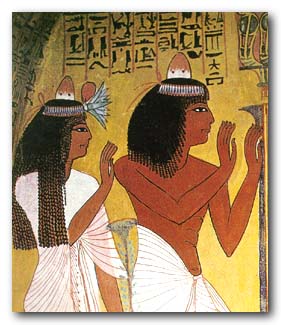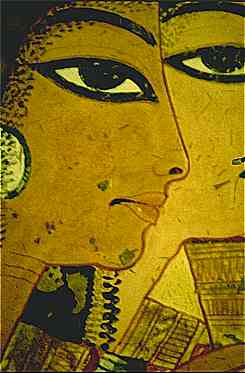 |
Beauty Through the Ages The Origins of Make-up
Ancient Egypt Most of the beauty advice you will find below is meant to be informative and amusing - however it is not recommended that readers take the advice given as much of it is out-of-date and more importantly, is now realised to be harmful! |

![]()
|
The
Origins of Make-up Lipsticks first appeared in the ancient city of Ur, near Babylon, 5000 years ago. Semi-precious stones such as lapis lazuli and malachite were ground to be used as eye shadows. It is said Cleopatra's lipsticks were made from finely crushed carmine beetles which made a deep red pigment. This was then mixed with ant's eggs as a base for the lipsticks. Yummy. Ancient Greek women painted their cheeks with herbal pastes made from crushed berries and seeds, but their men didn't like women to look anything other than plain except in the Greek court where they would make their cheeks look red by first coating their face, necks and breasts with a white powder before applying a rouge. At the time they didn't know that the white powder contained lead and over time would actually destroy their complexion, and in some cases: kill them. Women during the Middle Ages didn't wear much make-up, (although blush was worn by prostitutes) until Queen Elizabeth I became one of Britain's most celebrated users of natural beauty preparations. Elizabethan women still used white lead face paint and mercury sulphide for rouge, but the lead was mixed with vinegar to form a paste called ceruse. The white lead made hair fall out; and the extensive use of ceruse through the Elizabethan era explains the fashion for high foreheads, as hairlines receded. Lipsticks were a blend of cochineal and beeswax, and occasionally a stain made from dark red plant dyes. This look became the height of fashion in England and France during the 16th century but with powdered white wigs rather than Elizabeths' red ones. But there continued to be resistance to the idea of makeup: In 1792 a Gentlemen's magazine in England claimed that women with 'wooly white hair and fiery red faces' resembled skinned sheep. But after the French revolution the extravagance of make up was considered brazen and uncouth, and didn?t really hit a revival until the 1800s. By then, the use of any form of blusher, powder and lipstick had virtually disappeared in Europe and was allowed only on the stage. It was thought that any woman that put lipstick or blusher on was trying to capture a lost youth, and was considered a fake. Closer to modern times women moved on to a beauty product that was eaten to produce a white skin: Arsenic Complexion Wafers. They worked by poisoning the blood so it transported fewer red blood cells (and less oxygen) to organs. A rouge was made of vegetable substances such as mulberry, which were harmless, but it was coloured with cinnabar, a poisonous red shade of mercury. The red cream was also used to paint the lips, (the first lipstick) where it could be easily ingested. Ancient beauty practices not only killed their users occassionally, but poisoned unborn babies as well, resulting in miscarriages. Throughout history there have been attempts to ban women from using cosmetics: not for their health or safety, but because they were considered immoral or contrary to religious beliefs. One Greek Historian from the 4th century wrote about his bride deceiving him prior to their marriage ? by wearing make up that didn't show her true looks. Another Greek, Clement of Alexandria, proposed a law that would prevent women from using cosmetics lest it tricked their husbands into marrying them; and as recently as 1770 a law was put forward to the British parliament proposing that any marriage that was entered into with a woman who used cosmetics prior to the wedding day could be annulled. - MAYBELLINE/nzgirl.com |
|
 Perfume balls sit atop the head |
Ancient Egypt
Perfumes of Ancient Egypt The Egyptians used three methods of releasing fragrance. Perhaps the oldest method was via burning. This technique is evoked and recalled in the modern word perfume, literally "through smoke." Fragrant materials could also be added to oils or to animal fats (goose, ox or pork) or fruit pastes, like the legendary kyphi, a temple fragrance, which was based upon raisins. As you can imagine, these fragrances would have felt different from what we call perfume today.
Unguents, fragrant ointments or pastes, are similar to what we know today as solid perfume or perfumed cream. Because they are liquid, perfumed oils are perhaps closest to the texture associated with modern perfume. |
In ancient Egypt, everyone wore eye make up -- men, women and children of all castes, according to historians. Scientists now think the cosmetics may have had as much to do with health as with beauty or style.
Egyptologists and chemists came to that conclusion after analyzing the contents of the Louvre's collection of 4,000-year-old pots once used in Egyptian makeup kits. They found chemical compounds that were used thousands of years later by the Greeks and Romans to treat infectious eye diseases such as conjunctivitis and trachoma.
'Egypt Revealed' by Bethannie, aged 15
http://www.freezone.com/brain/egypt/story1.html
Thousands of years before the United States was declared independent, the people of Ancient Egypt were adorning their hair, eyes, lips and nails with powders, oils and pigments.
 |
The main focus of Egyptian makeup was on the decoration of the eyes. Whether this stemmed from the need to protect the eyes from the sun (sort of like football and baseball players put those lines of "eye-black" under their eyes to keep the sun from reflecting into their vision) or the desire to make their eyes look as marvelous as those of the sun god Re, as two of my sources say, they did indeed put heavy emphasis on the color and decoration of their eyes. As a base, the bottom edge of the eye was edged in a pale green made from wet powdered malachite and the eye was then outlined with a dark juice created by grinding up ants' eggs. They used a black colored wet powder called kohl which was created in several different ways, a few of which are: powdered burnt almonds, frankincense, antimony, and the one which surprises me the most - a mixture of lead and various other substances. Hopefully they did not ingest any of that makeup, on purpose or by accident, because then they would get lead poisoning! The bottles which contained the kohl were usually decorated with yellow and white patterns on a purple-blue background. In many instances, these eye makeup containers have been found in the tombs of Ancient Egyptians, along with the applicator sticks. |
14th Century
A Medieval Miscellany, selected and edited by Judith Herrin, published by Weidenfield and Nicolson Facsimile Editions, London, 1999
Geoffroi de Charny describes the dangers of fine clothing and counsels humility among those seeking to dress fashionably.
If anyone is thus elegantly dressed and in good fashion, as befits a young man, it should not be done through pride nor should Our Lord be forgotten; but be careful not to spruce yourself up so much that you do not remember God, for if you do not remember God, God will not remember you. But one should dress well when in company with other young people and to fit in with them; and it is a fine and good thing to spend one's youth in honest fashion, and those who spend it thus should praise God all their lives.
As for the youth of noble ladies, damsels and other women of high rank, it can indeed be said that... it is fitting to wear fine circlets, coronets, pearls, precious stones, rings, embroidery, to be beautifully dressed, their heads and bodies well adorned according to what is right and fitting for each person to do; it is much more suitable for them to wear fine adornments than for men, for young damsels sometimes achieve better marriages when they are seen in rich apparel that suits them.
For those that have the will to rise to great achievement, how can they better adorn themselves than by being equipped for it by all the good qualities? They can do so by being men of worth, wise, loyal, without arrogance, joyful, generous, courteous, expert, bold and active...
 |
17th Century - The Elizabethan Period
Elizabethan Make-up 101
by Drea Leed
Richard Brathwait, The English Gentlewoman
William Horman, Vulgaria |
"For the Freckles which one getteth by the heat of the Sun: Take a little Allom beaten small, temper amonst it a well brayed white of an egg, put it on a milde fire, stirring it always about that it wax not hard, and when it casteth up the scum, then it is enough, wherewith anoint the Freckles the space of three dayes: if you will defend your self that you get no Freckles on the face, then anoint your face with the whites of eggs."
Christopher Wirzung,General practise of Physicke, 1654.
"To make the hair yellow as golde. Take the rine or scrapings of Rubarbe, and stiepe it in white wine, or in cleere lie; and after you have washed your head with it, you shall weatte your hairs with a Spoonge or some other cloth, and let them drie by the fire, or in the sunne; after this weatte them and drie them againe."
1756
'The Beauty Spot' a short story by Alfred de Musset
"Fashion is a strange thing. Our grandmothers found it quite all right to go to court with immense robes which left their bosoms almost uncovered, and none saw any indecency in that, but they religiously kept their backs hidden, and the fair ladies to-day display their backs in the opera balcony. It is a newly invented form of beauty."
1830
Victorian Beauty Hints,
http://www.geocities.com/Wellesley/Garden/3258/beauty-hints.html
Visit this page to immerse yourself in Victoriana!
Light colors such as blues, lilacs and yellows were popular. Taffetas, organdies, satins and silks were used most frequently. The wasp waist was emphasized by wearing large belts and skirts were full. Other details were leg of mutton sleeves with feather cushions or wicker frames to puff them out, a sloaping shoulder line along with berthas and square shawls and cabriolet bonnets.
Victorian Era
Chapped Hands
Mix a quarter of a pound of unsalted hog's-lard, which should be washed first in water and then in rose-water,with the yolk of a new-laid egg and a large spoonful of honey. Add to this as much fine oatmeal or almond paste as will make the whole into a paste, and apply this after washing the hands. Godey's Ladys Book Vol XLVIII January to June, 1854 p 187
Receipt For Washing The Head
Take a fresh laid egg; beat it throughly; then rub it upon the head into the hair with the hands until it begans to feel dry; then rinse with clear water; either warm or cold, as you please, till the water runs clear. As this leaves the hair dry, with a decided tendency to curl, some oil is necessary, and the best is bear's oil, if you can get it. I do not mean the stuff that is sold under that name so often. Genuine bear's oil gives the hair a smooth, glossy look that no other oil will, while it is perfectly healthy both for the head and the hair. Godey's Ladys Book Vol LIII July to December, 1856 p 183
1930's
Beauty Adorned by Elizabeth Ann, 1935
The cultivation of arm loveliness: It is essential in the cult of the beautiful that you have gently rounded tapering arms. Do you posess the sort of arm that tapers from the shoulder into an indent, out again to the elbow, exposes the joint of the elbow, and then finishes, more or less, at a gaunt angle down to your wrist? You are forever going to be arm conscious and at least one third of your arm enjoyment is going to be marred every time you catch a mirrored or sidelong glance at yourself.
Your loveliest gowns will be disappointing if you reveal arms of a different hue from that of your face and throat. Each morning, particularly during the warmer months, treat them to a brisk patting with your own favoured skin-toning lotion, and keep them fresh throughout the day.
For elbows that have become discoloured, take the pulp from half a lemon, place it in the palm of one hand, and cup the elbow of the other in the palm. The merest whisper of rouge applied to the elbow will disguise the prominence while you effect a cure.
1940's
An extract from 1940's advertising copy, entitled War, Women and Lipstick
For the first time in history, women-power is a factor in war. Millions of you are fighting and working side by side with your men. It's a reflection of the free democratic way of life that you have succeeded in keeping your femininity, even though you are doing a man's work. No lipstick - ours or anyone else's - will win the war, but ir symbolises one of the reasons why we are fighting... the precious right of women to be feminine and lovely under any circumstances.
1950's
Feminine Beautification In America, 1958
With a clink of vials and a wafting of odoursm the rite begins. It is 6.45am, and her husband is still abed, but pretty Mrs James Locke sits before a mirrored table in her San Francisco apartment, her blonde hair covered by a filmy nylon cap. Over an array of multi-scented bottles, sticks and tubes, Jean Locke hovers like an alchemist. She cleans her skin of night-cream, anoints it with icy water - and for one brief moment shows her true face. Then, slowly, comes the metamorphosis. Over her face she spreads a foundation cream, creating a pale, expressionless mask. She caresses her cheeks with a liquid rouge for colour, and tops it off by gently patting on a flesh-coloured powder. She shadows her eyes with turquoise, dabs a few drops of perfume behind her ears, at her elbows, temples and wrists. With a dark pencil she shapes her eyebrows to give an artful lift to her expression, brushes her eyelashes with a penlike wand to emphasise her blue eyes. Finally, twenty minutes later, she spreads on the finishing touch - an orange lipstick to match her fingernail polish.
1960's
In Search of Charm by Mary Young, 1962
Facial Expression
In biting winds: how can you look attractive with a screwed up face which seems to be saying 'I just can't bear it'? Try relaxing your face to the wind, thinking, 'Wonderful cold wind' and pretend you are thoroughly enjoying it. Everyone will take a second look at your radiant expression.
In the heat: You can't look attractive if you are visibly wilting. Try holding up your face as though you're blissfully revelling in the sunshine and warmth. Everyone around will be asking how you keep so cool.
Red nose in winter: Avoid that red-nosed cold-pinched look by using enough rouge to keep the cheeks a little pinker than the nose.
Do you know? On getting up it is a good thing to bend over with the head hanging and pull and pull at the hair until the whole scalp is tingling. This attracts circulation to the roots, as well as waking you up.
Drying hair after home shampoo and set: Practise with scarves, turbans and false fringes until you have found how to look glamorous while your hair is drying. (With a false fringe and an enormous white chiffon headsquare tied the model girl way, I go out and do my shopping while my hair is drying.)
Dressing table: This should always look immaculate and as expensively feminine as possible. An armoury of cosmetics gives the impression that your beauty only survives with the aid of these things.
1970's
Look Like a Million, by Leslie Field, 1978
Sex Appeal: Any woman who is proud of her face and body is going to be sexy. Maybe she won't have Farrah Fawsett-Major's face, or Raquel Welch's measurements, but she'll have a zest for life that every man will find appealing. Be happy, funny and more interested in other people that in yourself and you'll be the most fancied lady in town.
Disguising a disastrous hair-do: Fold a scarf into a triangle; pull it down across your forehead, and let the triangle end fall at the back of the neck, while knotting the two ends in your hands on top of it. Roll a second scarf in a long tube and tie it around your head at hairline level for contrast. Tuck in the flapping end.
Complexion: Has your complexion got an olive tinge? Give up all spirits for two weeks and see if your skin looks pinker and clearer. That drab hue may come from a bottle.
Tanning: Take Brewers Yeast tablets to increase the vitamin B in your body which produce the tanning pigment in your skin called melanin. The fairer your complexion, the less natural melanin you have. But if you suddenly find yourself with the chance to sunbathe, with no protective tanning lotion, a thin layer of foundation will be a sunblock for your face. The reflection from your sunglasses may burn your nose. Leave them off.

Great Beauty Myths - Beauty Through the Ages - The Great Cosmetic Ripoff - home